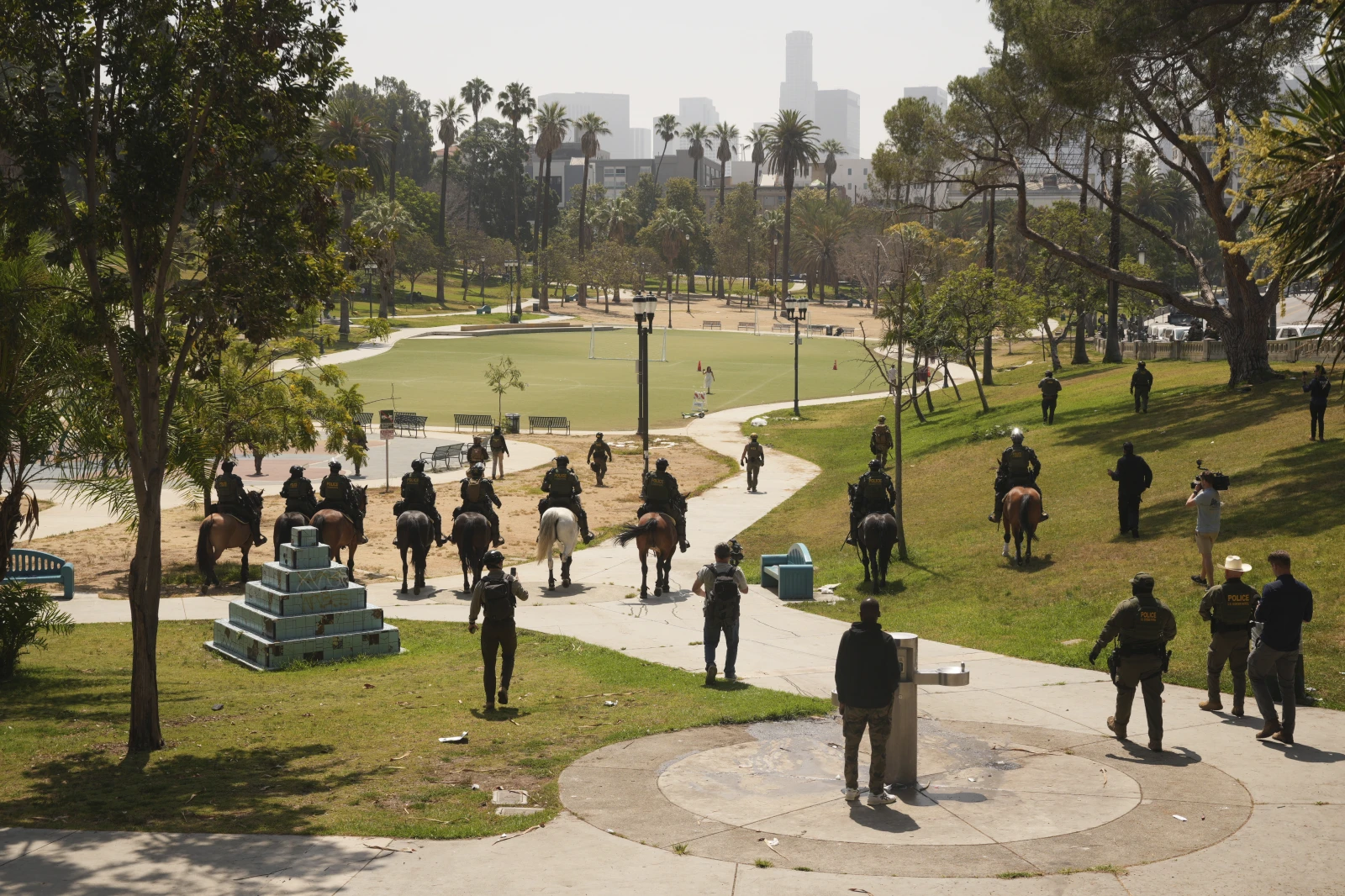On July 7, 2025, armored federal agents stormed MacArthur Park under the cover of helicopters, horseback units, and camouflaged National Guard trucks. The show of force, code-named Operation Excalibur, featured masked officers, soda-themed agency codenames, and zero arrests. It lasted just 24 minutes. Soldiers never left their trucks. Health workers were threatened at gunpoint, and children at a summer day camp fled the scene.
While the scale and absurdity of the Trump administration’s military-style raid were shocking, the underlying logic followed a pattern that has defined MacArthur Park for over a century: grand government interventions, often forceful or symbolic, without long-term commitment or care. The park has long been treated as a problem to be contained, a staging ground for political performance rather than a public space deserving of investment and stewardship.
That dynamic dates back to 1934, when the city of Los Angeles extended Wilshire Boulevard straight through the park, slicing it in half to accommodate car traffic. Hundreds of residents had protested the move, warning it would destroy the integrity of one of the city’s oldest and most beloved public spaces. The city ignored them. Construction crews drained part of the lake, filled in the land, and ran a road through the middle of what had once been a tranquil oasis. The message was clear: the needs of community would always come second to the demands of infrastructure and growth.
In the decades that followed, MacArthur Park became a neighborhood mirror—reflecting the city’s racial, economic, and political contradictions. As the surrounding Westlake area grew into one of the most densely populated immigrant communities in the country, the park fell into cycles of neglect and aggressive policing. In the 1980s and ’90s, it became a shorthand for everything city leaders claimed to fear: gangs, drugs, poverty, street vending. Police crackdowns became routine. Basic services evaporated. Public life was criminalized.
In 2003, a coalition led by LAPD Chief Charlie Beck and civil rights attorney Connie Rice brought together police, nonprofits, park officials, and neighbors to clean up the park and restore public use. There were concerts, gang peace walks, festivals, foot patrols, and weekend fishing derbies for kids. Families came back. Violence fell. But as always, the effort was short-lived. Beck was promoted and the resources dried up. The cycle reset. MacArthur Park became a place people passed by but rarely entered.
The most recent cycle began in early 2025, when a mass shooting near Alvarado Street prompted a citywide political panic. LAPD Chief Jim McDonnell declared a “zero tolerance” policy. The city installed chain-link fencing that displaced dozens of street vendors—many elderly or disabled—without providing any alternatives. The fencing did nothing to reduce crime. What it did was make clear who the city wanted to remove.
In public, Mayor Karen Bass and Councilmember Eunisses Hernandez promised a more compassionate, coordinated approach. They announced partnerships for overdose prevention, mental health outreach, and community-centered planning. But weeks later, without meaningful coordination with the city, federal agents rolled in with Operation Excalibur. The military briefing language described the park as the “founding location of MS-13” and “the largest open-air market of fake identification in the Southwest.” The threat assessment read like a battlefield report. Yet no arrests were made. Guardsmen later admitted they never left their vehicles. Most of the time was spent sweating in the backs of trucks. Communications broke down. The entire operation, according to soldiers and leaked documents, was a failure—logistically incoherent and operationally pointless. But it accomplished what it was designed to do: instill fear.
The irony is that, while federal agents treated the park like enemy territory, city planners were moving forward with a project to undo the damage from 1934. In July 2024, the city secured a $2 million federal grant to begin the “Reconnecting MacArthur Park” initiative, aimed at studying the closure of Wilshire Boulevard between Park View and Alvarado and physically reuniting the park. The plan includes community input, environmental review, and temporary street closures to test the concept. For once, the city seemed willing to acknowledge the harm of past planning decisions and create space for healing.
But even that gesture now risks being swallowed by the same pattern that has defined the park for decades. Street vendors like Juan Rodriguez have seen it all before. After the fences went up in January, he put it plainly: “The crime is still there. What the fencing did was punish the poorest people.” MacArthur Park has never lacked ideas. Again and again, it has been “saved” by political leaders, only to be abandoned when the cameras leave. And through it all, the people who use the park—immigrants, workers, families—are pushed out or pushed aside. It is not just a space, but a symptom of what happens when a city forgets to care for the places that make it whole.

